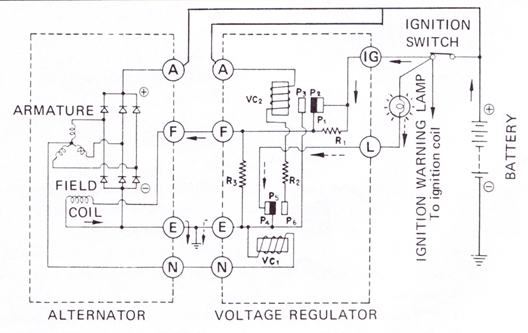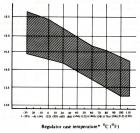| Revision as of 09:08, 20 November 2012 ddgonzal (Talk | contribs) (->Testing) <- Previous diff |
Revision as of 04:36, 4 August 2013 ddgonzal (Talk | contribs) (->Testing) Next diff -> |
||
| Line 16: | Line 16: | ||
| = Testing = | = Testing = | ||
| The regulator should keep voltage output of the alternator between 13.5 - 15.0 volts (exact specs vary by temperature, see the [[Factory service manual]]. If out of specification, it is possible to adjust the regulator. But it is far easier to replace the regulator. | The regulator should keep voltage output of the alternator between 13.5 - 15.0 volts (exact specs vary by temperature, see the [[Factory service manual]]. If out of specification, it is possible to adjust the regulator. But it is far easier to replace the regulator. | ||
| + | |||
| + | First: Check the [[Fuse Box]]. The 'M' fuse (Meter/Reverse/Regulator) powers the voltage regulator. If this fuse is bad, the alternator will not charge the battery. | ||
| To test the Regulator: | To test the Regulator: | ||
Revision as of 04:36, 4 August 2013
The Datsun 1200 Alternator uses an external voltage regulator. This is a precision device with magnetic coils and moving contact points. They generally last about 10 years of normal driving. B110 regulator uses spade terminals, and so is different from B210 which uses round pins. It controls the alternator output to between 13.5-15.0 volts, by rapidly vibrating moving point. Newer regulators are available that are more reliable with solid-state circuits (no moving parts).
Also see: Alternator Wiring.
Contents |
Location
The voltage regulator is mounted in the engine compartment, on the left strut tower. It is the rectangular box mounted on front of the strut tower (left strut, right side of photo)
It is in the same location for coupe and sedan, RHD and LHD.
1974-up 1200 utes have the alternator on the other side of the engine. The regulator may be in a different location.
Testing
The regulator should keep voltage output of the alternator between 13.5 - 15.0 volts (exact specs vary by temperature, see the Factory service manual. If out of specification, it is possible to adjust the regulator. But it is far easier to replace the regulator.
First: Check the Fuse Box. The 'M' fuse (Meter/Reverse/Regulator) powers the voltage regulator. If this fuse is bad, the alternator will not charge the battery.
To test the Regulator:
- Put a voltage meter across the battery terminals
- With engine running, at 1200 RPM:
- Battery fully charged: Voltage must be at least 13.5 volts or battery won't be properly charged
- Battery low: Voltage must be at least 12.5 @ 1100 RPM with headlights on
- Voltage must be no higher than 15.0 volts or battery damage may result
If it is too high (over 15.0 volts):
- Test output at Regulator, from A terminal and Ground terminal.
- If in spec here, but too high at the battery, there is a wire corrosion problem somewhere. Clean and inspect the wires at battery, cable and wiring harness.
- If output is too high at regulator, replace or adjust Regulator
If it is too low
- Test output at Regulator, from A terminal and Ground terminal.
- If in spec at the regulator, but too low at the battery, there is a wire corrosion problem somewhere. Clean and inspect the wires at battery, cable and wiring harness.
- If too low at the regulator, peform Regulator Bypass Test
Regulator Bypass Test
- With key off, unplug T-connector from the alternator
- Insert jumper wire with spade connector to the F terminal in the T-opening.
- Place voltage meter across battery terminals
- With engine running, touch jumper to A terminal on alternator (+12V).
- If voltage jumps to 13.5 volt or more, the regulator is bad
- If voltage is still low, replace or repair the Alternator. Often it just need a $10 brush replacement.
Also see Alternator Wiring
Voltage
Voltage for a standard lead-acid automative battery depends on temperature. Here are specs for a typical a Datsun regulator:
Temperature, Voltage 14F 14.0-15.5 32F 14.5-15.5 50F 14.8-15.3 68F 14.2-15.2 88F 14.0-15.0 104F 13.9-14.9
Advanced Battery
If you have an advanced lead-acid battery (AGM, Optima, etc), follow the manufacturer's recommendation on charging voltage. While these batteries can handle a wider range of charging voltages, they will last longer if the voltage is tightly controlled.
For example, Optima recommends this charging for thier AGM batteries:
Optima Yellowtop - Alternator: 13.65 to 15.0 volts, no amperage limit
Optima Bluetop/Redtop - Alternator: 13.3 to 15.0 volts, no amperage limit
Adjustment
Part Numbers
Nissan
- PN 23500-N3300 (same as 70-73 240Z, and 68-73 510)
- replaced by: 23500-29906 $103 USD (which also replaced 70-72 521 pickup)
- AIRTEX 1V1250 $18 USD
- ACDELCO E661 $40
- GP Sorensen 265003 $48 USD
B110 rectangular connector (with spade terminals)
- 23500-29901 REGULATOR-VOLTAGE (HITACHI TL135)
- 23500-29902 -0972 replaces 01
- 23500-N3300 1072- replaces 02 $84.12
- 23500-29911 $75.67
- ACDELCO Part # E661 {#88925052} $51.99
- AIRTEX Part # 1V1250 $43.79
B210 1974 Round Connector
- $35.79 RockAuto
B210 1975-1977 Rectangular Connector (with round pins)
- $57.89

![[Datsun 1200 encyclopedia]](/wiki/upload/wiki.png)










